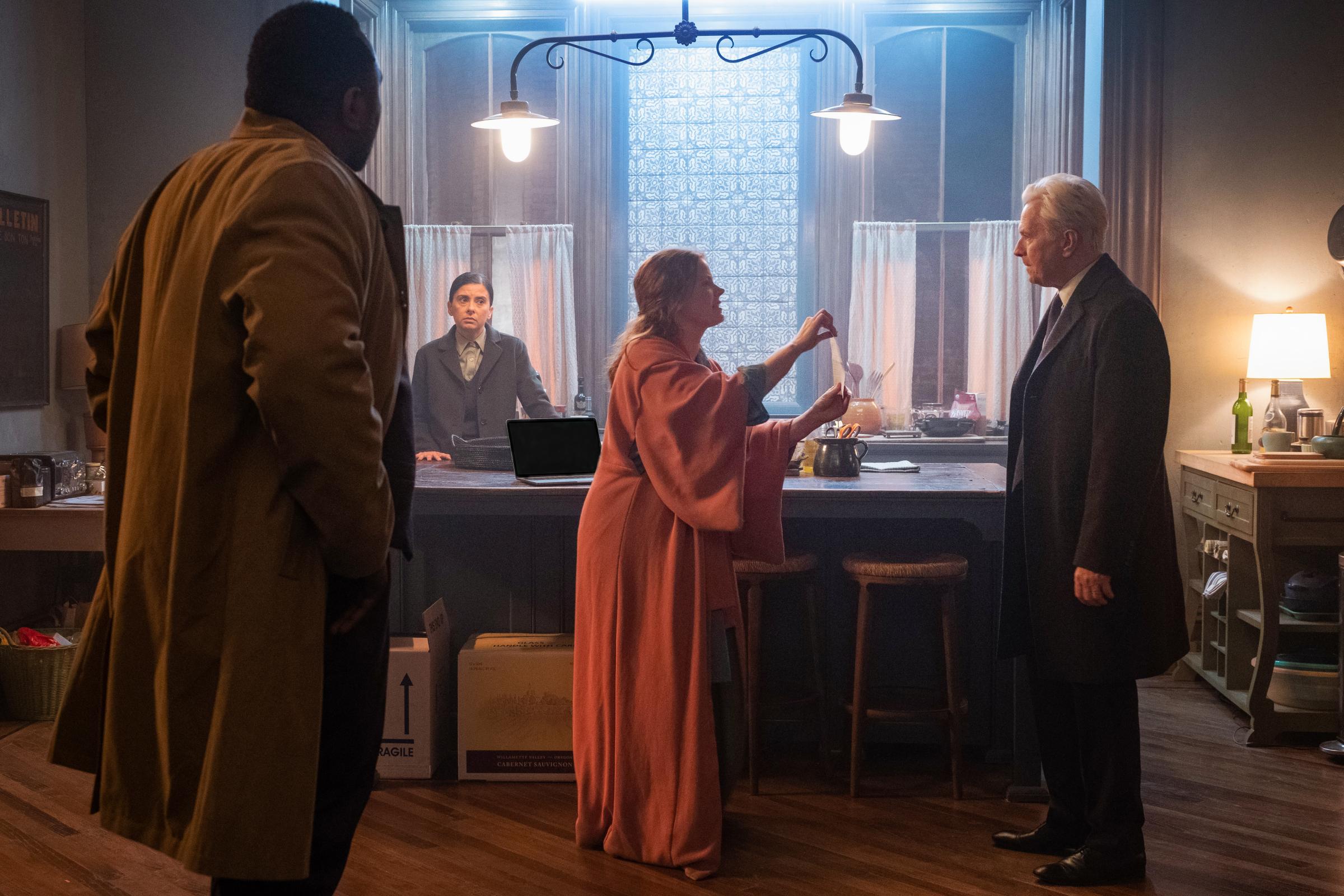Agoraphobia has rarely looked as classy as it does in Joe Wright’s coolly tasteful psychological thriller The Woman in the Window: Amy Adams plays Anna Fox, a woman who cannot bring herself to leave her comfortably appointed if dimly lit Harlem townhouse, spending her days and nights in a moody haze induced by the anti-anxiety drugs her shrink (Tracy Letts) has prescribed for her, which she pairs with copious amounts of red wine. Anna drifts from room to room in a sweeping, dark-pink bathrobe, like a wan Victorian heroine who has time-travel-shopped from the Garnet Hill catalog. She watches old movies on DVD, finding companionship in their black-and-white shadows. And she looks out the window; her circumscribed existence is widened, slightly, by the signs of life she sees in the checkerboard pattern of windows opposite. Any reference to Alfred Hitchcock’s Rear Window is strictly intentional: early on we catch a glimpse of James Stewart’s face, in all its neurotic postwar glory, on Anna’s TV screen. His Jeff Jefferies is her dream twin, a man who has come to prefer the prurient watching of life to actually living it.
The Woman in the Window is adapted from A.J. Finn’s 2018 novel (Letts wrote the screenplay), and Wright shapes it into a modern gothic tale of obsession, voyeurism and possible madness, as prismatic and furtive as a leaded-glass window. The picture is enjoyable not so much for its twisty plot—which, even if you haven’t already read the book, is essentially pretty guessable—as for its artful dedication to its own highly theatrical, drapes-drawn somberness. Cinematographer Bruno Delbonnel follows our fragile, frazzled protagonist through her nest of rooms as if the camera knows she’s in danger of being swallowed by her own house. Best to keep an eye on this troubled creature, with her frizzy, undone hair and her tired, pink-rimmed rabbity eyes. Adams is good at this kind of role: she’s a bundle of nerve endings, but she gives off a sympathetic, fiberoptic glow.
So what happens in The Woman in the Window? How much can really happen to a woman who lives alone and refuses to leave her own house? A lot, apparently. And while you’re never alone in the city, a place like New York can still be the loneliest place on Earth. We’re clued in that Anna used to know some other kind of life: she’s separated from her husband (Anthony Mackie), who lives elsewhere with their young daughter, though she speaks to him regularly—he cares for her, even in light of her problems, though he also tries to keep her grounded in reality. And there’s a part of her that wants both to reach out and to be reached out to. She has become peculiarly obsessed with some new neighbors across the street, the Russells, and when one of them, 15-year-old Ethan (Fred Hechinger), stops by with a gift for her, she reluctantly allows him into her lair. He’s shy and awkward but sweet, and he draws Anna out of her shell just a bit. It turns out she’s a psychologist, one who works with kids—or used to, before she became frozen in her life at home.

Anna becomes drawn into the life of Ethan and his family, as she views it from her perch across the way. She briefly meets Ethan’s eternally angry father (Gary Oldman in a white, Raymond Burr-style coif) and doesn’t like him much, though she takes a shine to the boy’s mother (played, with hard blond hair and a brittle laugh, by Julianne Moore). But life as it’s glimpsed through a grid of windows isn’t always reality—and Anna’s grip on reality seems tenuous to begin with. When she witnesses what she’s sure is a murder, she can hardly believe her own eyes, and we’re hesitant to believe them as well.
Read more reviews by Stephanie Zacharek
The Woman in the Window is one heck of a movie to release just as most of us are getting ready to leave our homes after more than a year of pandemic confinement, hoping to get reacquainted with our normal selves. Would it be as effective during normal times? Probably. At a crucial moment, Anna runs to dial 911, but her landline doesn’t work; she grabs her cellphone and finally gets through, only to find she’s so rattled she can’t answer the dispatcher’s basic questions. Maybe that’s a page drawn from the nightmare textbook, but it’s unnerving even so. There’s more: freaked out and unable to sleep, Anna engages, unwisely, in frantic nocturnal Googling (there should be a word for this—Noctoogling?), that thing so many of us do late at night, tapping away at the keyboard as we follow every dark nautilus swirl of our sleepless brains. Will Anna ever be able to bring herself to go outside again? That’s the real suspense of The Woman in the Window, and giving yourself over to it is much more enjoyable than obsessively refreshing Twitter and Instagram, untrustworthy windows if ever there were any, as you wait for the world to restart.
More Must-Reads from TIME
- Why Trump’s Message Worked on Latino Men
- What Trump’s Win Could Mean for Housing
- The 100 Must-Read Books of 2024
- Sleep Doctors Share the 1 Tip That’s Changed Their Lives
- Column: Let’s Bring Back Romance
- What It’s Like to Have Long COVID As a Kid
- FX’s Say Nothing Is the Must-Watch Political Thriller of 2024
- Merle Bombardieri Is Helping People Make the Baby Decision
Contact us at letters@time.com